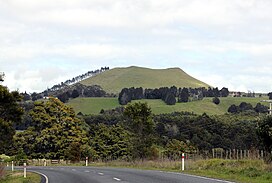Te Ahuahu
Appearance
| Te Ahuahu | |
|---|---|
 Te Ahuahu, looking from Waimate North | |
| Highest point | |
| Elevation | 373 m (1,224 ft) |
| Coordinates | 35°20′21″S173°50′28″E/ 35.339284°S 173.84109°E |
| Geography | |
 Te Ahuahu (red marker) and associated scoria and lava fields.Tarahiis to the south.
Clicking on the map enlarges it, and enables panning and mouseover of volcano name/wikilink and ages before present. Key for thevolcanicsthat are shown with panning is:basalt(shades of brown/orange),monogeneticbasalts, undifferentiated basalts of the Tangihua Complex inNorthland Allochthon, arc basalts,arc ring basalts,andesite(shades of red),basaltic andesite,rhyolite,(ignimbriteis lighter shades of violet), andplutonic.White shading is selected caldera features. | |
| Geology | |
| Age of rock | Pleistocene |
| Mountain type | Basaltic scoria cone |
| Type of rock | Basalt |
Te Ahuahuis a 373 m (1,224 ft) high andesitic basalticscoria coneto the east ofLake Ōmāpere,in theKaikohe-Bay of Islands volcanic fieldinNew Zealand.[1]
History
[edit]It was the site of thepāofHōne Heke– a highly influentialMāorirangatira(chief) of theNgāpuhiiwi(tribe) – that was the scene of theBattle of Te Ahuahuduring theFlagstaff Warof 1845–46. Here on 12 June 1845 a Maori raiding party led byTāmati Wāka Nenecaptured the pā after Heke left it to gather food. During failed attempts to retake the pā, Heke was seriously wounded when shot in the thigh and at least 30 of his men were killed or wounded.[2]
References
[edit]- ^Hayward, Bruce; Smith, Ian (2002)."Field Trip 7: A Taste of Northland Geology"(PDF).In Smith, Vicki; Grenfell, Hugh (eds.).Field Trip Guides, GSNZ Annual Conference "Northland 2002".Geological Society of NZ Miscellaneous Publication 112B.Retrieved28 March2012.
- ^"Puketutu and Te Ahuahu – Northern War".Ministry for Culture and Heritage – NZ History online. 3 April 2009.Retrieved7 January2023.
